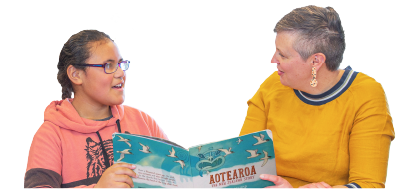Dual heritage
Show video transcript
Title slide: Dual heritage
Michelle Tamua, Parent, South Auckland, facing camera
I am a Palagi New Zealander, who is married to a New Zealand born Samoan and he is from Salelesi in Upolu and we have 7-year-old identical twin boys, who are of dual heritage. It’s very important to me that children in New Zealand with dual heritage feel that their identities are recognised and embraced. My boys go to a Bilingual Samoan unit at a mainstream school in south Auckland and so they see their “Samoan - ness” enacted every day in their classroom. But there are lots of children of dual heritage that are in mainstream classrooms too. My aspirations for my boys is that they grow up with a deep understanding of Fa’a Samoa. They have their Palagi heritage around them all the time and so it is more important to me that their understanding of Fa’a Samoa and the values of Fa’a Samoa grow within them and are centred within them, that they are proud of being Samoan, that they enjoy being Samoan and that they can walk in those two worlds really effectively.
Mary Jane Carter, Supervisor, Te Punanga o Te Reo Kuki Airani, Wellington
Children in the centre, singing
When my son Maddox was born I thought it was very important for him to be, to get to know his language and culture, to know about multiculturalism because in our nation we're not just kuki airani, Māori, we are from different nations.
Mary Jane Kauraka-Seiuli, Parent, Administrator, Te Punanga o Te Reo Kuki Airani, Wellington, facing camera
So it's important to me that when my son transitioned to school that he knew the importance and the uniqueness of everyone around him and his community. It's not just important for me to foster his identity, it was important for me and my husband to foster as a Pacific Islander in New Zealand. So because I had affiliations and I was very tight with my Cook Island community I thought it was important that he had a push to start somewhere. And then I also left it as my husband's responsibility to foster his Samoan side by introducing him to their way.
Teachers, adults and children in the centre
Because our language is so extinct right now, I thought it was very important that he grew up with me. And that he met the village that brought me up and that that was instilled in him so that when he transitioned he thought about the importance of community.
Michelle Tamua, Parent, South Auckland, facing camera
I think to support me and my aspirations for my kids and their education, Palagi teachers can ask the questions. So one of the things that we find is because I tend to be the person who takes them, who took them to daycare and who takes them to school, that teachers will make the assumption that my boys don’t have any Samoan, that it’s just a tick on their enrolment form. So it is very important to me that the teachers ask me what we are doing at home, what my boys know. That I see the boys’ Samoan identity in their classroom, in the environment of their classroom, in the way they are taught, in the way that they’re acknowledged and in the way that their Samoan values are respected and enacted in that classroom too.
This video is about recognising a learner’s dual heritage at school. A parent in the video speaks about the importance of children in New Zealand with dual heritage to feel that their identities are recognised and embraced, the benefits of dual language, and differences between Pacific learners who are in mainstream classrooms and those who are in bilingual units. Another parent speaks about her son Maddox and what is important for him in his identity and getting to know his language and culture. The video also challenges non-Pacific teachers to ask questions and dig deeper into a learner’s identity to understand them better.
Reflections for individual teachers
As you watch this video, think of the benefits and challenges of learners’ dual heritage and what they bring to the classroom.
- What are the models of dual language education that you use in your classroom? Also, consider thinking about the myths associated with learners of dual heritage.
- How are you valuing the literacies and skills that Pacific learners have gained in their first language, and make clear connections with school literacy? How can your Pacific learners build on these?
How are you ensuring that second language acquisition is assessed? How are you checking with your learner to see if they require support?
Reflections for staff or departments
As you watch this video, think about how learners of dual heritage can thrive in your school environment.
- How is your school integrating Pacific culture into classroom content?
- What support system for Pacific students do you have in place to allow them to support each other? How are you empowering Pacific learners with dual heritage to thrive in their learning?
- What opportunities does your school offer Pacific learners to embrace their dual heritage and use their home languages at school?
How does your school support learners’ expression in their indigenous language, and build on the recognition of a learner’s first language to help build their confidence and a sense of being cared for?

